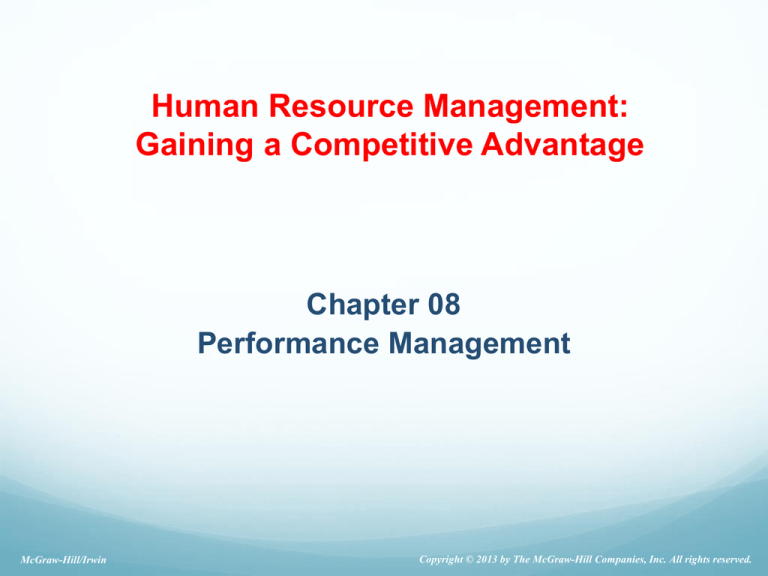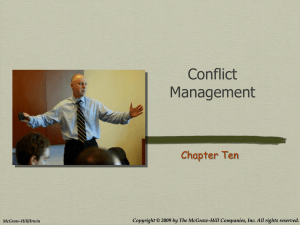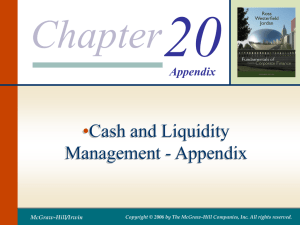
Human Resource Management:
Gaining a Competitive Advantage
Chapter 08
Performance Management
McGraw-Hill/Irwin
Copyright © 2013 by The McGraw-Hill Companies, Inc. All rights reserved.
Learning Objectives
Identify major determinants of individual performance.
Discuss three purposes of performance management.
Identify five criteria for effective performance
management systems (PMS) .
Discuss four approaches to performance management,
specific techniques used in each approach and ways
these approaches compare with criteria for effective
PMS.
8-2
Learning Objectives, cont.
Choose the most effective approach to performance
measurement for a given situation.
Discuss advantages and disadvantages of different
sources of performance information.
Choose the most effective sources for performance
information.
Distinguish types of rating errors and explain how to
minimize each in a performance evaluation.
Conduct an effective performance feedback session.
Identify the cause of a performance problem.
8-3
Introduction
Performance Management is the process through
which managers ensure that employees’ activities and
outputs are congruent with organizational goals.
Performance Appraisal is the process through which
an organization gets information on how well an
employee is doing his or her job.
Performance Feedback provides employees
information regarding their performance effectiveness.
8-4
Process of Performance Management
8-5
3 Purposes of Performance Management
8-6
5 Criteria of Performance Measures
Specificity
8-7
Reliability
Defined as the consistency of a performance
measure
Interrater reliability – consistency among the
individuals who evaluate an employee’s
performanc
Internal consistency reliability – whether
questions designed to measure the same facet
of performance deliver the same results
Test-retest reliability – the ability to deliver the
same results when a performance measure is
administered at different times
McGraw-Hill/Irwin ©2012 The McGraw-Hill Companies, All Rights
Reserved
Acceptability
McGraw-Hill/Irwin ©2012 The McGraw-Hill Companies, All Rights
Reserved
McGraw-Hill/Irwin ©2012 The McGraw-Hill Companies, All Rights
Reserved
Measuring Performance
Comparative approach compares performance with
that of others.
Ranking
Simple ranking ranks employees from highest to
lowest performer.
Alternation ranking is crossing off the best and
worst employees.
Forced distribution is employees ranked in groups.
Paired comparison
Managers compare every employee with every
other employee in work group.
8-11
Forced Distribution & Ranking
McGraw-Hill/Irwin ©2012 The McGraw-Hill Companies, All Rights
Reserved
Attribute Approach
Graphic rating scales
list of traits evaluated by 5-point rating scale.
legally questionable.
Mixed-standard scales
define relevant performance dimensions
develop statements representing good, average,
and poor performance along each dimension.
8-13
Graphic Rating Scale
The Graphic Rating Scale is the most common form of the
attribute approach used in performance management – however,
graphic rating scores have been criticized as subjective
McGraw-Hill/Irwin ©2012 The McGraw-Hill Companies, All Rights
Reserved
Mixed Standard Scale
McGraw-Hill/Irwin ©2012 The McGraw-Hill Companies, All Rights
Reserved
Behavioral Approach
Critical incidents approach requires managers to keep
record of specific examples of effective and ineffective
performance.
Behaviorally anchored rating scales (BARS)
Behavioral observation scales (BOS)
Organizational behavior modification is a formal
system of behavioral feedback and reinforcement.
Assessment centers are multiple raters who evaluate
employees’ performance on a number of exercises.
8-16
BARS for a Patrol Officer
McGraw-Hill/Irwin ©2012 The McGraw-Hill Companies, All Rights
Reserved
Sample BOS
It is generally agreed that a BOS provides the best means for differentiating
employee performance
Competency Model
Competencies are sets of skills, knowledge, abilities and
personal characteristics that enable employees to
successfully perform their jobs.
A competency model identifies competencies necessary for
each model and provides descriptions common for an entire
occupation, organization, job family or specific job.
Also useful for recruiting, selection, training and development.
8-19
Competency Assessment for a
Managerial Position
McGraw-Hill/Irwin ©2012 The McGraw-Hill Companies, All Rights
Reserved
Strengths and Weaknesses of the
Behavioral Approach
Strengths include effectiveness, the ability to link
business strategy with employee behaviors, can
have high validity when linked to job analysis,
are generally highly accepted, and can be very
reliable when used properly
Weaknesses include difficulty in insuring that
behaviors are linked with the organization’s
strategy, assumes that favored behaviors are the
best way to perform the job, and can be less
suited to complex jobs
McGraw-Hill/Irwin ©2012 The McGraw-Hill Companies, All Rights
Reserved
Results Approach
Goals
Management by Objectives
top management passes down company’s
strategic goals to managers to define goals.
Productivity Measurement and Evaluation
System (ProMES)
goal is to motivate employees to
higher levels of productivity.
Hierarchy
8-22
Balanced Scorecard Approach
8-23
Strengths and Weaknesses of the
Results Approach
The results approach relies upon objective,
quantifiable measures of performance
Results measured can be contaminated (affected
by matters not under the employee’s control) and
deficient (not all important aspects of the job can
be measured), can also lead to inter-employee
competition instead of cooperation
McGraw-Hill/Irwin ©2012 The McGraw-Hill Companies, All Rights
Reserved
Quality Approach
A performance management system (PMS) designed
with a strong quality orientation can:
Assess both person and system factors in the
measurement system.
Emphasize managers and employees working
together to solve performance problems.
Involve both internal and external customers in
setting standards and measuring performance.
Use multiple sources to evaluate person and
system factors.
Sustainability is key element of quality approach.
8-25
Quality Approach
The quality approach assumes that the best
measurement of an individual’s performance is the
employee’s contribution to improving quality
outcomes for the organization
Kaizen – focuses on continuous improvements in
business processes and results
8-26
6 Statistical Process
Quality Control Techniques
1. Process-flow analysis
2. Cause-and-effect diagrams
3. Pareto chart
4. Control chart
5. Histogram
6. Scattergram
8-27
5 Performance Information Sources
8-28
Reducing Rater Errors and Politics
Appraisal Politics – where evaluators
purposefully distort a rating to acheive
personal or organizational goals
Approaches to Reducing Rater Error:
Rater error training – increase awareness of
rater errors
Rater accuracy training (frame of reference
training) – provides raters with idea of what is
high, medium, and low performance
Calibration Meetings- attended by managers to
discuss employee performance ratings.
8-29
McGraw-Hill/Irwin ©2012 The McGraw-Hill Companies, All Rights
Reserved
3 Ways Technology Influences PMS
Web-based Online paperless PMS Technology
-Social networking, etc.
8-31
Technology - Electronic Monitoring
Electronic tracking systems include:
Hand and fingerprint recognition systems
Global positioning systems (GPS)
Systems that track employees using handheld
computers and cell phones
Potential increased efficiency and
productivity benefits
Systems present privacy concerns.
8-32
Typical Rater Errors
1. Similar to Me
2. Contrast – compare with others
3. Leniency – rate too highly
4. Strictness – rate too harshly
5. Central Tendency – rate all as
mediocre
6. Halo – personal endorsement
7. Horns – personal animosity
Appraisal Politics- evaluations distort ratings to achieve goals.
8-33
McGraw-Hill/Irwin ©2012 The McGraw-Hill Companies, All Rights
Reserved
Improve Performance Feedback
1. Give feedback frequently, not once a year.
2. Create right context for discussion.
3. Ask employees to rate performance before the session.
4. Encourage employee to participate.
5. Recognize effective performance through praise.
6. Focus on solving problems.
7. Focus feedback on behavior or results, not on the person.
8. Minimize criticism.
9. Agree to specific goals and set progress review date.
8-35
8-36
Ways to Manage Performance
Solid performers
High ability and motivation; provide development
Misdirected effort
Lack of ability but high motivation; focus on training
Underutilizers
High ability but lack motivation; focus on
interpersonal abilities
Deadwood
Low ability and motivation; managerial action,
outplacement, demotion, firing
8-37
Withstand Legal Scrutiny
1. Conduct a valid job analysis related to
performance.
2. Base system on specific behaviors or results.
3. Train raters to use system correctly.
4. Review performance ratings and allow for
employee appeal.
5. Provide guidance/support for poor performers.
6. Use multiple raters.
7. Document performance evaluations.
8-38
Summary
Measuring and managing performance are key to gaining
competitive edge.
Performance management systems (PMS) serve strategic,
administrative and developmental purposes.
PMS should be evaluated against criteria of strategic congruence,
validity, reliability, acceptability and specificity.
Effective managers need to
be aware of the issues involved in determining best methods.
feed performance information back to employees
take action based on causes for poor performance: ability, motivation or
both
be sure that PMS can meet legal scrutiny
8-39








